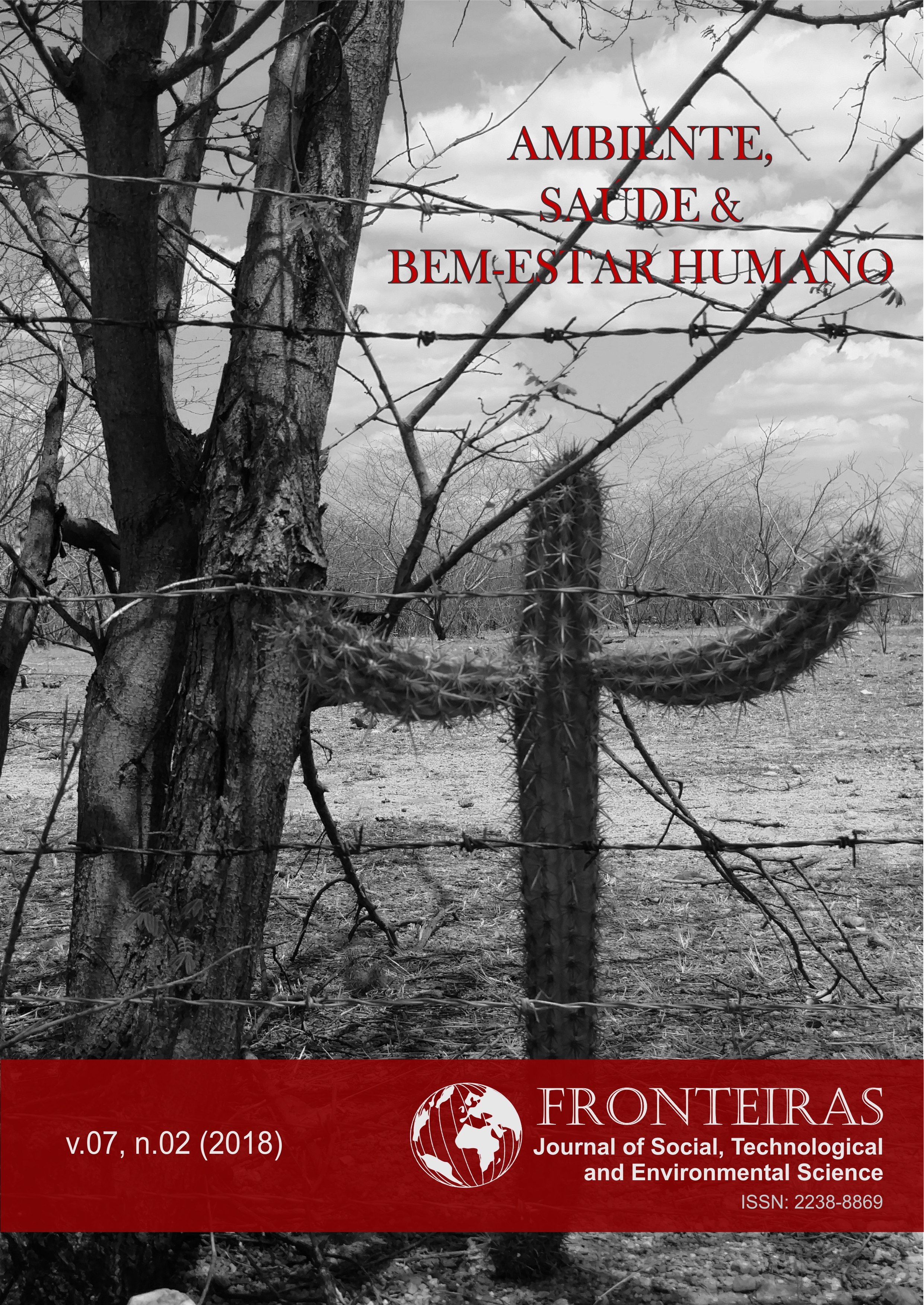Environment, Development and Expansion of Diseases Transmitted by Vectors
DOI:
https://doi.org/10.21664/2238-8869.2018v7i2.p49-63Keywords:
Environment, development, vector-borne diseasesAbstract
The environment as a system, Gaia theory (Lovelock), was changed by the different forms of production in the various stages of the development of capitalism, making the nature of the productive process hostage. The changes made in the environment have brought many consequences and not only characterized by climate change, since it resulted in interference in the habitat and the living conditions of the man and other living things. Some effects of these changes on the environment stand out especially in the field of health. Environmental modifications arising from human migrations, growth of cities, urbanization, deforestation, sharp construction of infrastructure networks, construction of dams, environmental disasters have resulted in various changes in nature and in the epidemiology of diseases transmitted by insect vectors, given the recent outbreak of yellow fever in Brazil.
References
Barcellos C et al 2009. Mudanças climáticas e ambientais e as doenças infecciosas: cenários e incertezas para o Brasil. Epidemiol. Serv. Saúde, 18(03):285-304.
Botelho CA, Natal D 2009. Primeira descrição epidemiológica da leishmaniose visceral em Campo Grande, Estado de Mato Grosso do Sul. Rev. Soc. Bras. Med. Trop. 42(5):.
Dutra e Silva et al 2015. Colonização, Saúde e Religião: A medicina pioneira e o poder simbólico da moral social na Colônia Agrícola Nacional de Goiás - CANG (1941-1959). Fronteiras: Journal of Social, Technological and Environmental Science 4(1):85-109.
IBGE 2010. Censos Demográficos, IBGE, Brasil.
Brazil RP 2013. The dispersion of Lutzomya longipalpis in urban areas. Rev Soc Bras Med Trop 46(3):263-264.
Brito MA 2013. Investment in drugs for neglected diseases: a portrait of the last five years. Rev Soc Bras Med Trop 46:1-2.
Capra F 2010. A teia da vida. 16.ed, Cultrix, São Paulo.
Chame M 2015. Rompimento da barragem de Mariana traz impactos imediatos para pessoas e ecossistemas. CISS-Centro de Informação em Saúde Silvestre, Rio de Janeiro. Acesso em: 03 fev.2018. Disponível em: https://www.biodiversidade.ciss.fiocruz.br/rompimento-da-barragem-em-mariana-traz-impactos-imediatos-para-pessoas-e-ecossistemas.
Curtin PD 1996. Disease and imperialism. In David A (org.). Warm Climates and Western Medicine: The Emergence of Tropical Medicine, 1500-1900. Atlanta: Rodopi, Amsterdã, p. 99-107.
Curtin PD 1998. Disease and Empire: the health of European troops in the conquest of Africa. University Press, Cambridge.
Giddens A 2010. A Política da Mudança Climática. Zahar, Rio de Janeiro.
Marzochi MCA, Fagundes A, Andrade MV 2009. Viseral Leishmaniosis in Rio de Janeiro, Brasil: Co-Epidemiological Aspects and Control. Rev Soc Brasil Med Trop 42:570-580.
Michalick MSM 2016. Leishmaniose visceral americana. In Neves DP, Melo AL, Linardi PM, Vitor RWA (eds.), Parasitologia Humana. 13.ed. Atheneu, São Paulo, p. 69-88.
Parreiras M 2018. Qual a relação do surto de Febre Amarela com o desastre de Mariana, Estado de Minas, Minas Gerais. Acesso em: 30 jan. 2018. Disponível em: https://www.em.com.br/app/noticia/gerais/ 2018/01/28/interna_gerais,934090/febre-amarela-desastre-mariana-barragem.shtml.
Pedro AFP 2017. Lama da Samarco no surto de Febre Amarela?, Ambiente Legal, São Paulo.
Philippe Jr A, Malheiros TF 2014. A crise socioambiental e a questão do desenvolvimento sustentável. In Philippe Jr A, Pelicioni MCF, Educação Ambiental e Sustentabilidade. 2.ed. rev/atual, Manole, Barueri.
Radis 2017a. Comunicação em Saúde n.173. FIOCRUZ, Rio de janeiro, 5pp.
Radis 2017b. Comunicação em Saúde n.174. FIOCRUZ, Rio de Janeiro, p. 13-17
Rodrigues et al 2015. Identificação de novos fármacos contra a doença de Chagas através de estratégia de genômica e bioinformática. Fronteiras: Journal of Social, Technological and Environmental Science 4(1):77-84.
Santos JV 2017. Surto de febre amarela está diretamente ligado à perda de biodiversidade. entrevista com Márcia Chame. IHU on-line, Rio Grande do Sul. Acesso em: 30 jan.2018. Disponível em: http://www.ihu.unisinos.br/159-noticias/entrevistas/564680-surto-de-febre-amarela-esta-diretamente-ligado-a-perda-de-biodiversidade-entrevista-especial-com-marcia-chame.
Santos M 1993. A urbanização brasileira. Hucitec, São Paulo.
Schaff A 1995. A sociedade informática. Ed. Univ. Paulista/ Brasiliense.
Schweickardt JC, Lima NT 2007. Os cientistas brasileiros visitam a amazônia: as viagens científicas de Oswaldo Cruz e Carlos Chagas (1910-1913). História, Ciência e Saúde – Manguinhos, 14(suplemento):15-50.
Silva GAR, Boechat TO, Ferry FRA, Pinto JFC, Azevedo MCVM, Carvalho RS, Motta RN, Veras MF 2014. First case of autochthonous human visceral leishmaniasis in the urban center of Rio de Janeiro: case report. Rev. Inst. Med. Trop, 56(1):81-84.
Takata R 2017. Novas técnicas contra uma antiga ameaça. Ciec. Cult, 69(2):09-11. Acesso em: 30 jan. 2018. Disponível em: http://dx.doi.org/10.21800/2317-66602017000200004.
Tamayo COC, Carvalho MSL, Bredt A 2010. Autochtonous visceral leishmaniasis in Brasilia, Federal District, Brazil. Rev. Soc Brasil Med. Trop 43:396-399.
Tavares et al 2015. A Lepra Mora no Morro: O “refúgio” de leprosos em Anápolis, Goiás, Brasil (1930–1970). Fronteiras: Journal of Social, Technological and Environmental Science 4(1):110-125.
Theodoro S, Barros JGC 2011. Política Nacional do Meio Ambiente: conquistas e perspectivas. In Theodoro SH (org.), Os 30 anos da política nacional do meio ambiente. Garamond, Rio de Janeiro.
Tilley H 2004. Ecologies of complexity: tropical environments, African trypanosomiasis, and science disease control in British Colonial Africa, 1900-1914. OSIRIS 19:21-38.
Worboys M 1996. Germs, malária and the invention of mansonian tropical medicine: From “disease in the tropics” to “tropical diseases”. In David A (org.). Warm climates and western medicine: the emergence of tropical medicine, 1500- 1900. Rodopi, Amsterdã/Atlanta, p. 181-207.
Worboys M 1994. The comparative history of sleeping sickness in east and central Africa, 1900-1914. Hist. Sci, 32:89-102.
Zombini EV, Pelicioni MCF 2014. Saneamento básico para saúde integral e a conservação do ambiente. In Philippe Jr A, Pelicioni MCF. Educação Ambiental e Sustentabilidade. 2.ed. rev/atual, Manole, Barueri.
Downloads
Published
How to Cite
Issue
Section
License
This journal offers immediate free access to its content, following the principle that providing free scientific knowledge to the public, we provides greater global democratization of knowledge.
As of the publication in the journal the authors have copyright and publication rights of their articles without restrictions.
The Revista Fronteiras: Journal of Social, Technological and Environmental Science follows the legal precepts of the Creative Commons - Attribution-NonCommercial-ShareAlike 4.0 International. 


